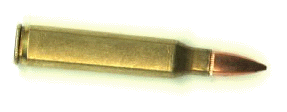The Cartridge |
|---|

|
|
The 223 Remington was developed between 1957 and 1959 at the behest of the Continental Army Command (CONARC). The result was military development of a new service rifle cartridge. Adopted
in February 1964 as the 5.56mm Ball Cartridge M193, it was introduced as a commercial cartridge by Remington one
month earlier.
Based on the 222 Remington case head dimensions, the 223 case is only .060" longer than its parent. However, it has greater powder capacity because the case body was lengthened and the neck shortened. With equivalent bullet weights, the 223 enjoys a 100 to 300 fps velocity advantage. This advantage is due to a combination of the larger case and higher operating pressures. Almost any military cartridge, once commercialized, is destined to become an immediate success and the 223 was no exception. The ready supply of cases and an excellent selection of 22 caliber bullets has made the 223 one of the most popular cartridges. Original military and commercial rifles had a 1:14 twist, later changed to 1:12 for better long range stability with the 55 grain service bullet. However, when the military adopted a heavier, 62 grain service round (the FN SS109 armor piercing round, M855) military rifles were fitted with 1:7 twist to better stabilize the heavier bullet. When fired at 3200 fps from a 1:7 twist rifle, the bullet is spinning at an incredible 329,142 RPM when it leaves the muzzle. This rotation is more than most varmint bullets can stand and they are thus ripped apart. This is about 30 times the RPM developed in a dragster, it's COOKIN guys!.
Let's Do The Math
That shows 5,485 revolutions per SECOND, that... is speedy. The commerical SAAMI 223 average pressure limit is 52,000 cup (copper units of pressure).
A Word of CautionMost manufacturers will caution reloaders when using used military brass. This brass tends to be heavier (thicker) than commercial brass and therefore loads should be reduced to limit pressures. I have heard people say that you can up the powder charge since the brass is thicker... this is definitely not the case !
My Favorite Load
Bullet: Winchester 55 gr (5.56mm or .223 depending on bore) boat tail I have loaded and fired over 5,000 rounds using this particular load. Jams, misfires and misfeeds are vitually non-existent if the weapon is properly maintained and the rounds are carefully loaded. It is an easy matter to hold 8" groups at 250 meters using iron sights. This load yields about 2700 fps and something less than 49,000 cup. Accurate Arms recommends a cartridge length of 2.230" for this load, however, with the increased overall length, pressures are reduced slightly for military brass and should be safe with all brass. This is a medium load and shows excellent accuracy. Accurate recommends a maximum powder charge of 26.0 grains for this bullet, with an overall length of 2.230" and a cup of 50,300, so you can see that this load will produce less than maximum pressures and velocity. It is my belief that lower pressures increase weapon and brass life, which overall tends to increase accuracy. A well placed bullet, regardless of the velocity, will always do the job. |
[an error occurred while processing this directive]
